Boiling Heat Transfer Enhancement on Biphilic Surfaces
Abstract
1. Introduction
2. Materials and Methods
2.1. Biphilic Surfaces and Their Fabrication Process
2.2. Experimental Setup
3. Results
3.1. Validation of the Experimental Setup and Measurement Technique
3.2. Experimental Results
4. Discussion
4.1. Effect of Surface Properties on Boiling
4.2. Comparison with Literature Data
4.3. Stability of the Biphilic Surfaces
5. Conclusions
- Boiling experiments were carried out using two types of biphilic surfaces obtained by different techniques. The degrees of heat transfer enhancement on nano-modified surfaces were determined. The effect of the size (0.05, 0.07, 0.1 mm), shape (circle, triangular, rectangular), and number of hydrophobic spots (32 to 506) on the boiling heat transfer rate on eight copper surfaces was studied.
- Both techniques demonstrated their effectiveness and provided a significant enhancement of boiling heat transfer. The heat transfer coefficient on biphilic surfaces was significantly (up to 600 %) higher than on smooth surfaces or surfaces coated with cocoons.
- The boiling heat transfer rate depended on the size of hydrophobic spots, the distance between them, and hence on their number. The results complement previous data [7,18] and show that heat transfer enhancement can be obtained on surfaces with a small diameter of hydrophobic regions (0.05 mm) and a relatively small area ratio (5%). At the same time, no significant effect of surface texture and shape of hydrophobic regions tested in this study on heat transfer was found.
- After long-term experiments (over 1 to 3 years), the heat transfer coefficient on the obtained surfaces remained higher than on a smooth copper surface. During 3 years of operation, the best stability of enhanced heat transfer was observed for biphilic surfaces with cavities formed by laser ablation.
Author Contributions
Funding
Institutional Review Board Statement
Informed Consent Statement
Data Availability Statement
Conflicts of Interest
Nomenclature
References
- Liang, G.; Mudawar, I. Review of pool boiling enhancement by surface modification. Int. J. Heat Mass Transf. 2019, 128, 892–933. [Google Scholar] [CrossRef]
- Li, W.; Dai, R.; Zeng, M.; Wang, Q. Review of two types of surface modification on pool boiling enhancement: Passive and active. Renew. Sustain. Energy Rev. 2020, 130, 109926. [Google Scholar] [CrossRef]
- Chen, J.; Ahmad, S.; Cai, J.; Liu, H.; Lau, K.T.; Zhao, J. Latest progress on nanotechnology aided boiling heat transfer enhancement: A review. Energy 2021, 215, 119114. [Google Scholar] [CrossRef]
- Kamel, M.S.; Lezsovits, F.; Hussein, A.K. Experimental studies of flow boiling heat transfer by using nanofluids A critical recent review. J. Therm. Anal. Calorim. 2019, 138, 4019–4043. [Google Scholar] [CrossRef]
- Surtaev, A.S.; Serdyukov, V.S.; Pavlenko, A.N. Nanotechnologies for thermophysics: Heat transfer and crisis phenomena at boiling. Nanotech. Russia 2016, 11, 696–715. [Google Scholar] [CrossRef]
- Dedov, A.V. A Review of Modern Methods for Enhancing Nucleate Boiling Heat Transfer. Therm. Eng. 2019, 66, 881–915. [Google Scholar] [CrossRef]
- Serdyukov, V.; Patrin, G.; Malakhov, I.; Surtaev, A. Biphilic surface to improve and stabilize pool boiling in vacuum. Appl. Therm. Eng. 2022, 209, 118298. [Google Scholar] [CrossRef]
- Motezakker, A.R.; Sadaghiani, A.K.; Çelik, S.; Larsen, T.; Villanueva, L.G.; Koşar, A. Optimum ratio of hydrophobic to hydrophilic areas of biphilic surfaces in thermal fluid systems involving boiling. Int. J. Heat Mass Transf. 2019, 135, 164–174. [Google Scholar] [CrossRef]
- Hummel, R.L. Means for Increasing the Heat Transfer Coefficient between a Wall and Boiling Liquid. U.S. Patent No. 3207209, 21 September 1965. Available online: https://patents.google.com/patent/US3207209A/en (accessed on 5 July 2022).
- Attinger, D.; Frankiewicz, C.; Betz, A.R.; Schutzius, T.M.; Ganguly, R.; Das, A.; Kim, C.-J.; Megaridis, C.M. Surface engineering for phase change heat transfer: A review. MRS Energy Sustain. 2014, 1, 4. [Google Scholar] [CrossRef]
- Betz, A.R.; Xu, J.; Qiu, H.; Attinger, D. Do surfaces with mixed hydrophilic and hydrophobic areas enhance pool boiling? Appl. Phys. Lett. 2010, 97, 141909. [Google Scholar] [CrossRef]
- Jo, H.; Ahn, H.S.; Kang, S.; Kim, M.H. A study of nucleate boiling heat transfer on hydrophilic, hydrophobic and heterogeneous wetting surfaces. Int. J. Heat Mass Transf. 2011, 54, 5643–5652. [Google Scholar] [CrossRef]
- Betz, A.R.; Jenkins, C.-J.; Kim, C.-J.; Attinger, D. Boiling heat transfer on superhydrophilic, superhydrophobic, and superbiphilic surfaces. Int. J. Heat Mass Transf. 2013, 57, 733–741. [Google Scholar] [CrossRef]
- Jo, H.J.; Kim, S.H.; Park, H.S.; Kim, M.H. Critical heat flux and nucleate boiling on several heterogeneous wetting surfaces: Controlled hydrophobic patterns on a hydrophilic substrate. Int. J. Multiph. Flow 2014, 62, 101–109. [Google Scholar] [CrossRef]
- Colombo, L.; Alberti, L.; Mazzon, P.; Antelmi, M. Null-space Monte Carlo particle backtracking to identify groundwater tetrachloroethylene sources. Front. Environ. Sci. 2020, 8, 142. [Google Scholar] [CrossRef]
- Wenzel, R.N. Resistance of solid surfaces to wetting by water. Ind. Eng. Chem. 1936, 28, 988–994. [Google Scholar] [CrossRef]
- Takata, Y.; Hidaka, S.; Kohno, M. Effect of surface wettability on pool boiling: Enhancement by hydrophobic coating. Int. J. Air-Cond. Refrig. 2012, 20, 1150003. [Google Scholar] [CrossRef]
- Yamada, M.; Shen, B.; Imamura, T.; Hidaka, S.; Kohno, M.; Takahashi, K.; Takata, Y. Enhancement of boiling heat transfer under sub-atmospheric pressures using biphilic surfaces. Int. J. Heat Mass Transf. 2017, 115, 753–762. [Google Scholar] [CrossRef]
- Sarode, A.; Raj, R.; Bhargav, A. Scalable macroscale wettability patterns for pool boiling heat transfer enhancement. Heat Mass Transf. 2020, 56, 989–1000. [Google Scholar] [CrossRef]
- Liang, G.; Chen, Y.; Wang, J.; Wang, Z.; Shen, S. Experiments and modeling of boiling heat transfer on hybrid-wettability surfaces. Int. J. Multiph. Flow 2021, 144, 103810. [Google Scholar] [CrossRef]
- Može, M.; Zupančič, M.; Golobič, I. Pattern geometry optimization on superbiphilic aluminum surfaces for enhanced pool boiling heat transfer. Int. J. Heat Mass Transf. 2020, 161, 120265. [Google Scholar] [CrossRef]
- Xia, Y.; Gao, X.; Li, R. Surface effects on sub-cooled pool boiling for smooth and laser-ablated silicon surfaces. Int. J. Heat Mass Transf. 2022, 194, 123113. [Google Scholar] [CrossRef]
- Zupančič, M.; Steinbücher, M.; Gregorčič, P.; Golobič, I. Enhanced pool-boiling heat transfer on laser-made hydrophobic/superhydrophilic polydime thylsiloxane-silica patterned surfaces. Appl. Therm. Eng. 2015, 91, 288–297. [Google Scholar] [CrossRef]
- Može, M. Effect of boiling-induced aging on pool boiling heat transfer performance of untreated and laser-textured copper surfaces. Appl. Therm. Eng. 2020, 181, 116025. [Google Scholar] [CrossRef]
- Khmel, S.; Baranov, E.; Vladimirov, V.; Safonov, A.; Chinnov, E. Experimental study of pool boiling on heaters with nanomodified surfaces under saturation. Heat Transf. Eng. 2021. Available online: https://www.tandfonline.com/doi/full/10.1080/01457632.2021.2009211 (accessed on 5 July 2022).
- Cho, H.R.; Park, S.C.; Kim, D.; Joo, H.-m.; Yu, D.I. Experimental study on pool boiling on hydrophilic micro/nanotextured surfaces with hydrophobic patterns. Energies 2021, 14, 7543. [Google Scholar] [CrossRef]
- Freitas, E.; Pontes, P.; Cautela, R.; Bahadur, V.; Miranda, J.; Ribeiro, A.P.C.; Souza, R.R.; Oliveira, J.D.; Copetti, J.B.; Lima, R.; et al. Pool boiling of nanofluids on biphilic burfaces: An experimental and numerical study. Nanomaterials 2021, 11, 125. [Google Scholar] [CrossRef]
- Boinovich, L.B.; Emelyanenko, A.M. The behaviour of fluoro-and hydrocarbon surfactants used for fabrication of superhydrophobic coatings at solid/water interface. Coll. Surf. A Phys. Eng. Asp. 2015, 481, 167–175. [Google Scholar] [CrossRef]
- Boinovich, L.B.; Emelyanenko, K.A.; Domantovsky, A.G.; Chulkova, E.V.; Shiryaev, A.A.; Emelyanenko, A.M. Pulsed laser induced triple layer copper oxide structure for durable polyfunctionality of superhydrophobic coatings. Adv. Mater. Interfaces 2018, 5, 1801099. [Google Scholar] [CrossRef]
- Safonov, A.I.; Sulyaeva, V.S.; Gatapova, E.Y.; Starinskiy, S.V.; Timoshenko, N.I.; Kabov, O.A. Deposition features and wettability behavior of fluoropolymer coatings from hexafluoropropylene oxide activated by NiCr wire. Thin Solid Films 2018, 653, 165–172. [Google Scholar] [CrossRef]
- Chinnov, E.A.; Shatskiy, E.N.; Khmel, S.Y.; Baranov, E.A.; Zamchiy, A.O.; Semionov, V.V.; Kabov, O.A. Enhancement of heat transfer at pool boiling on surfaces with silicon oxide nanowires. J. Phys. Conf. Series 2017, 925, 012033. [Google Scholar] [CrossRef]
- Vladimirov, V.Y.; Khmel, S.Y.; Safonov, A.I.; Semionov, V.V.; Chinnov, E.A. Effect of fluoropolymer spots on pool boiling heat transfer. J. Phys. Conf. Series 2021, 2119, 012087. [Google Scholar] [CrossRef]
- Može, M.; Zupančič, M.; Golobič, I. Investigation of the scatter in reported pool boiling CHF measurements including analysis of heat flux and measurement uncertainty evaluation methodology. App. Therm. Eng. 2020, 169, 114938. [Google Scholar] [CrossRef]
- Rohsenow, W.M. A Method of Correlating Heat Transfer Data for Surface Boiling of Liquids; Technical Report No 5 (Heat Transfer Laboratory); MIT Division of Industrial Cooperation: Cambridge, MA, USA, 1951; Available online: https://dspace.mit.edu/handle/1721.1/61431 (accessed on 5 July 2022).

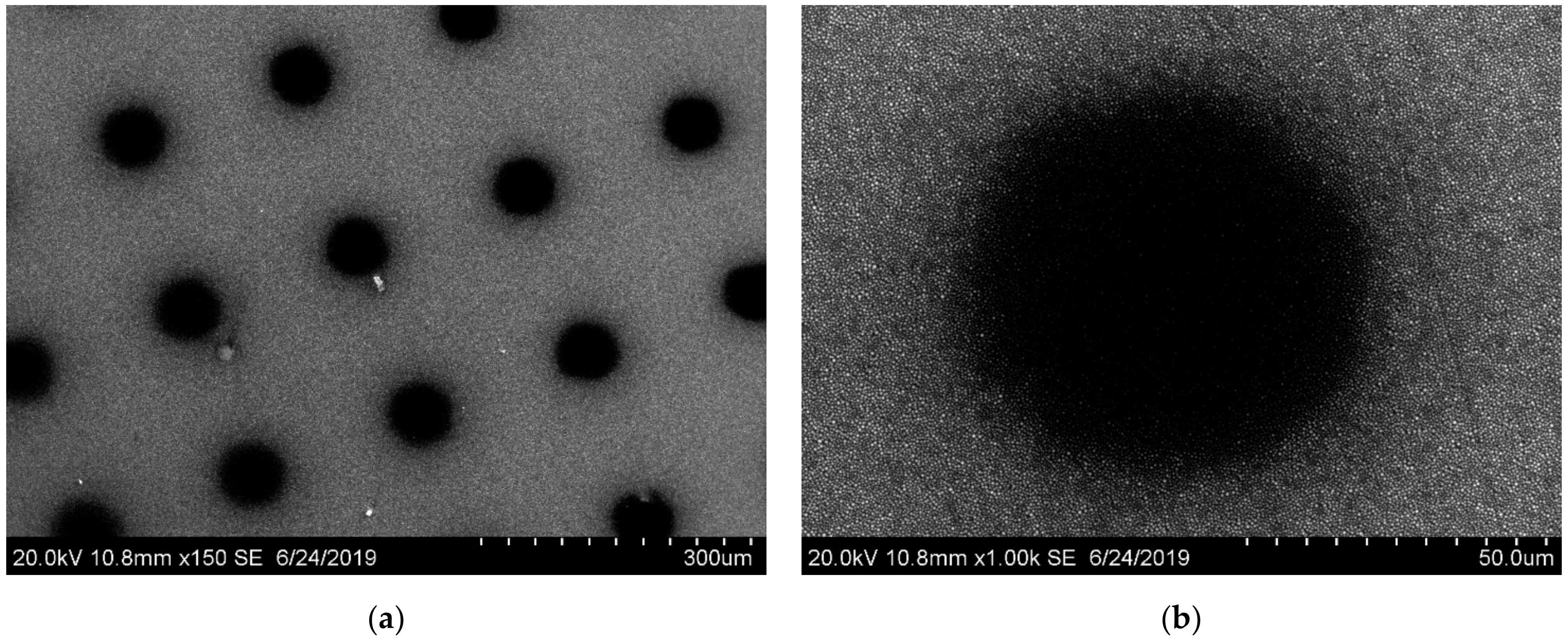

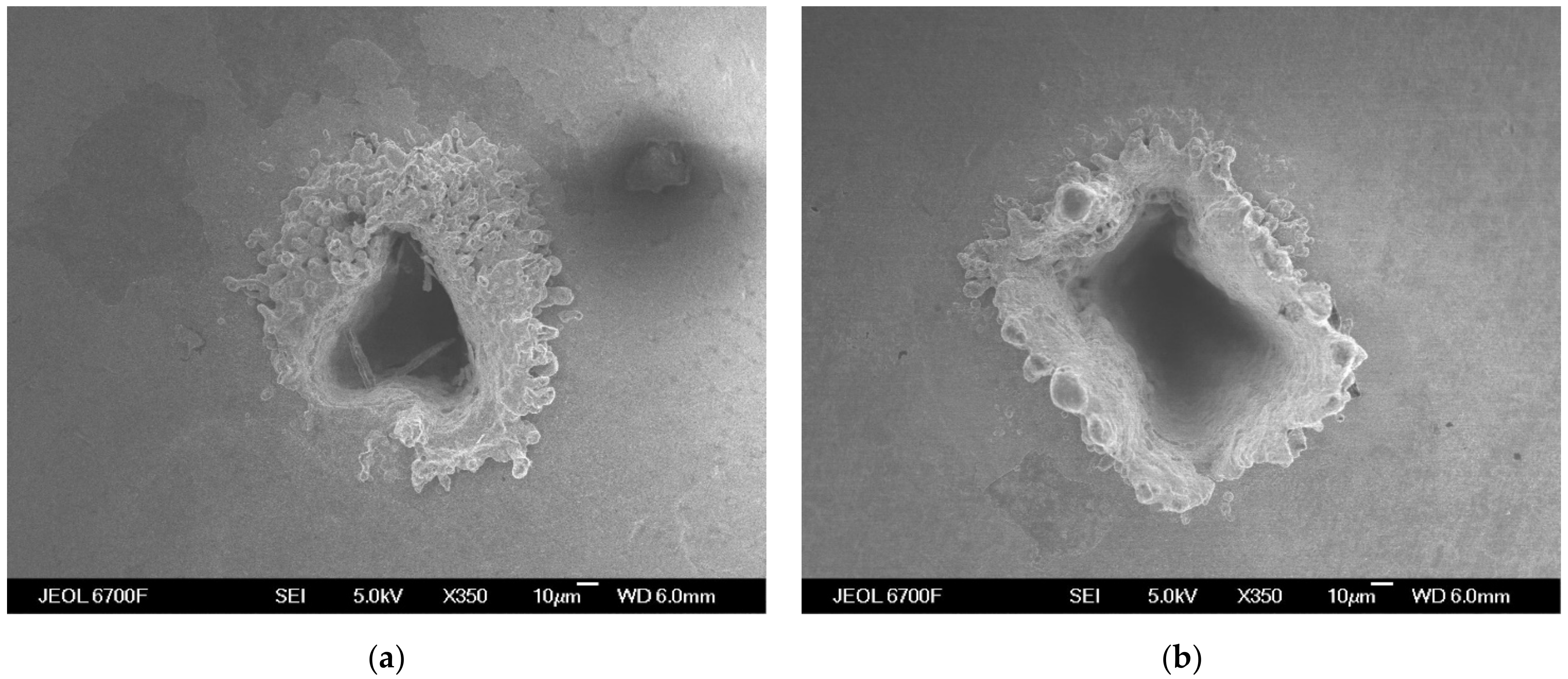
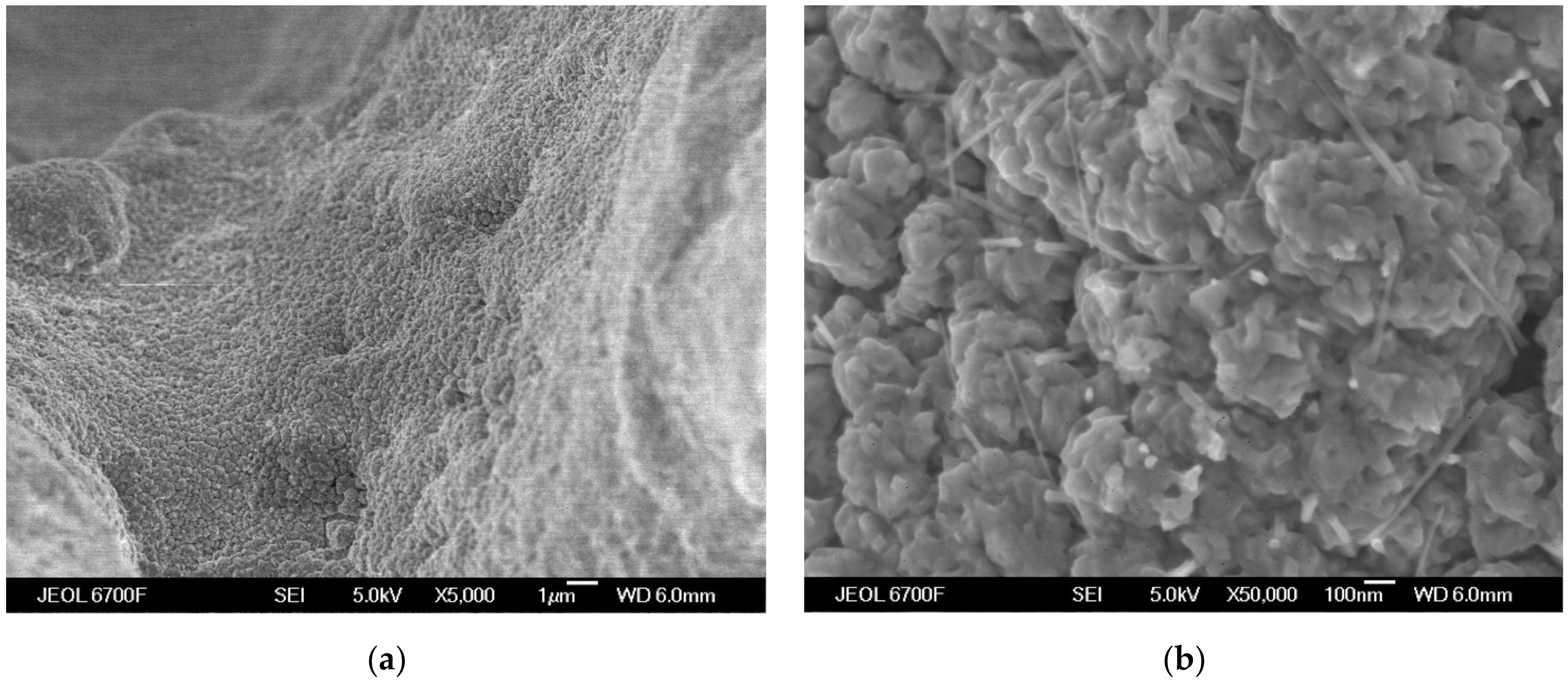

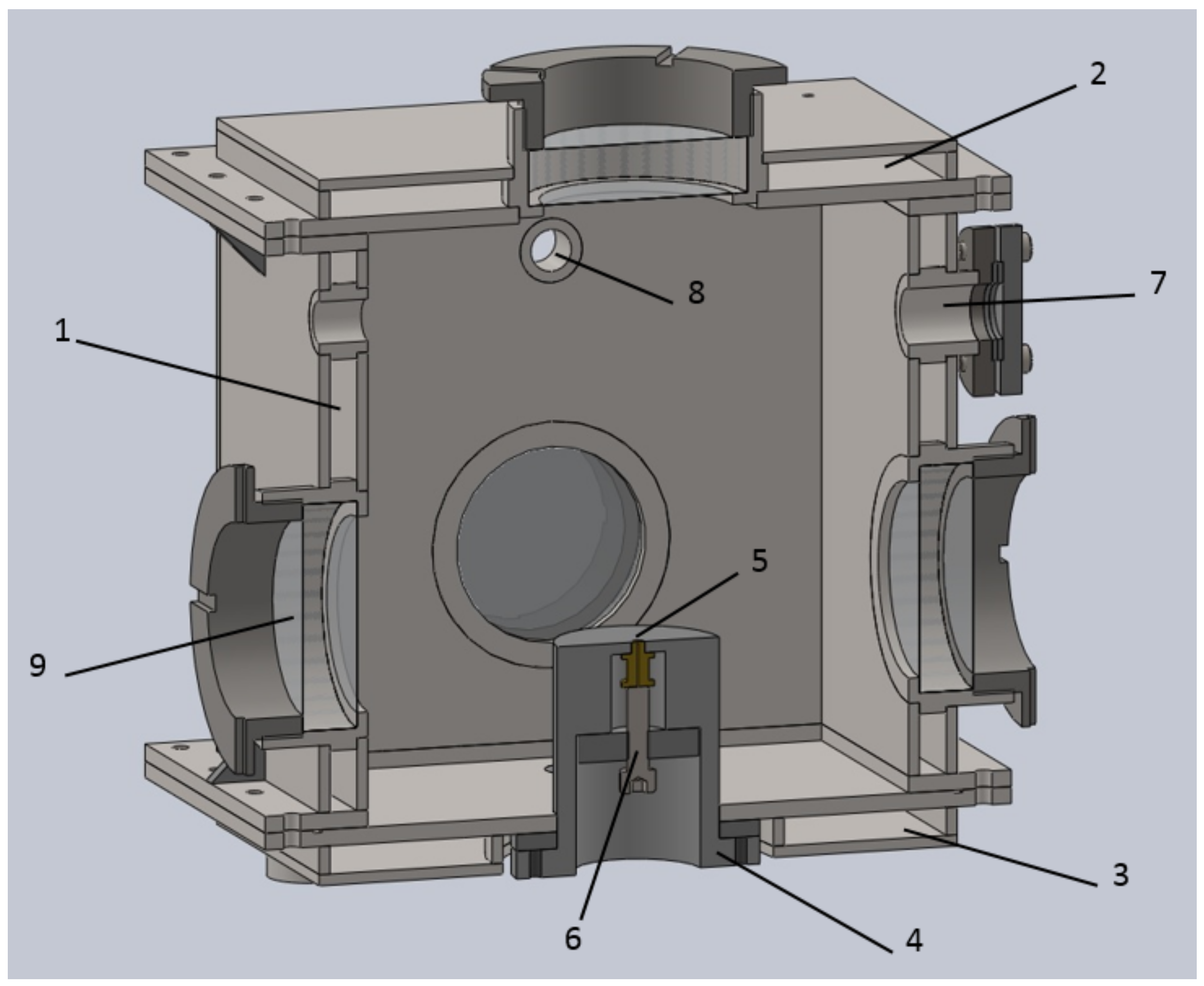

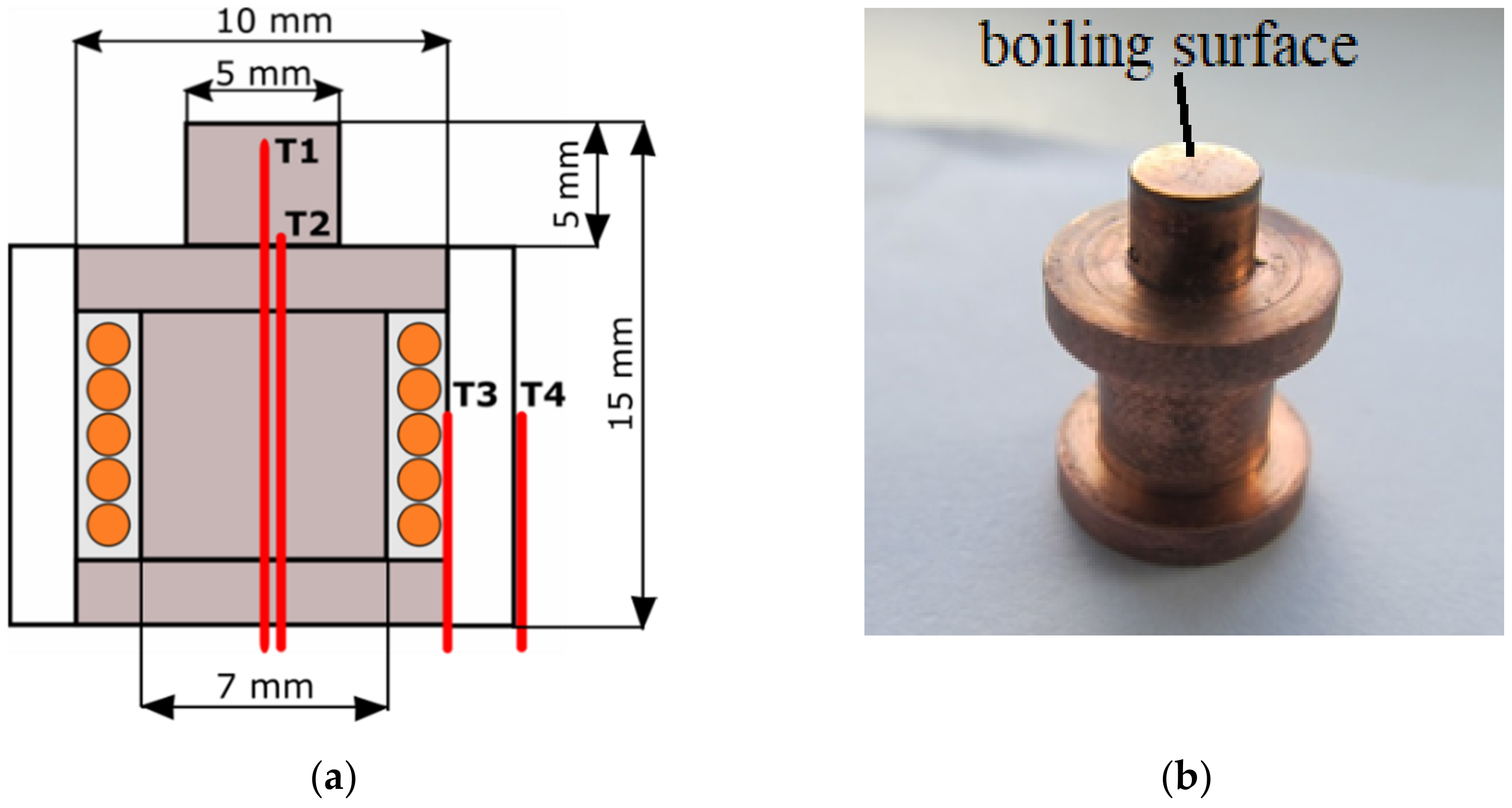
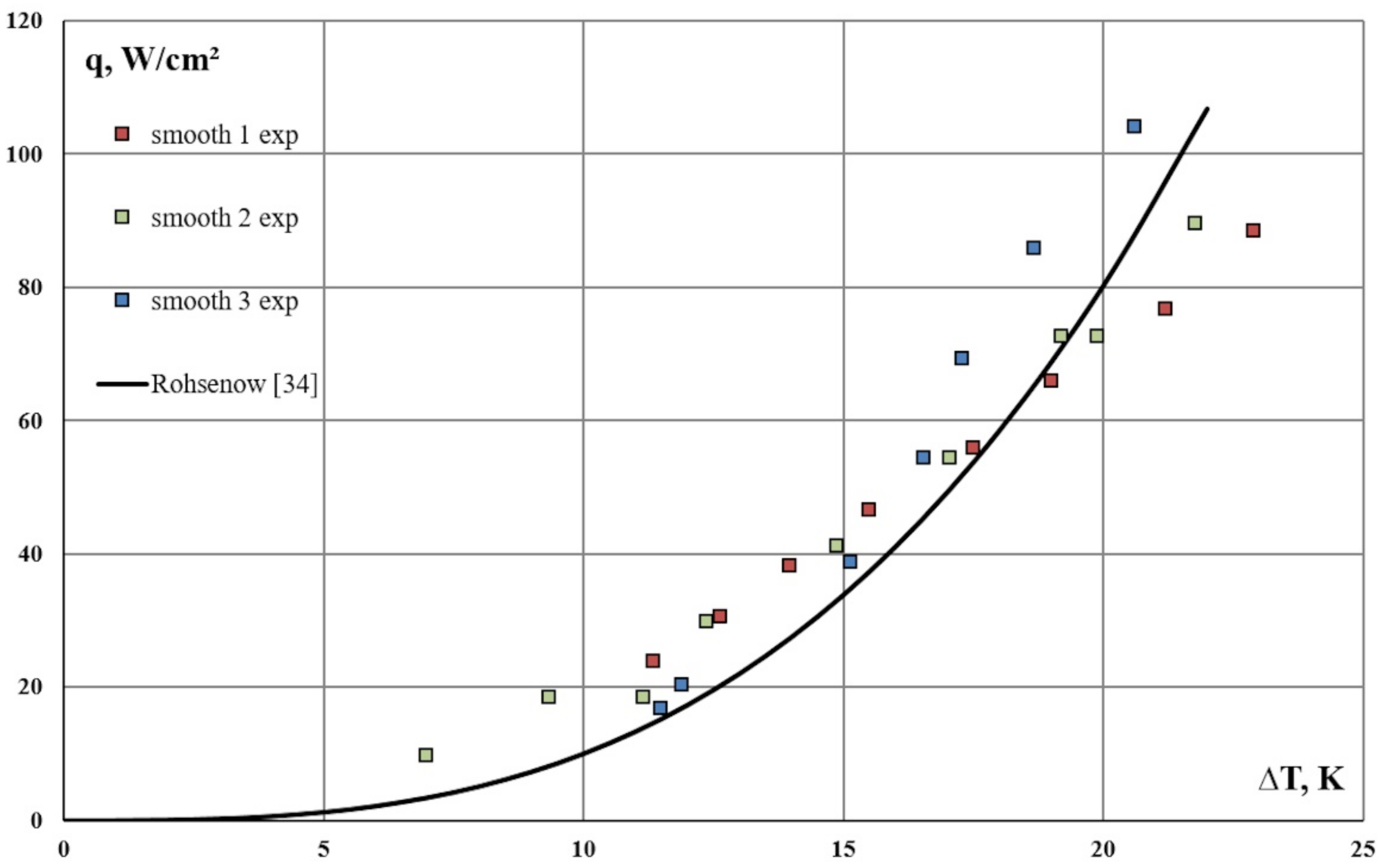
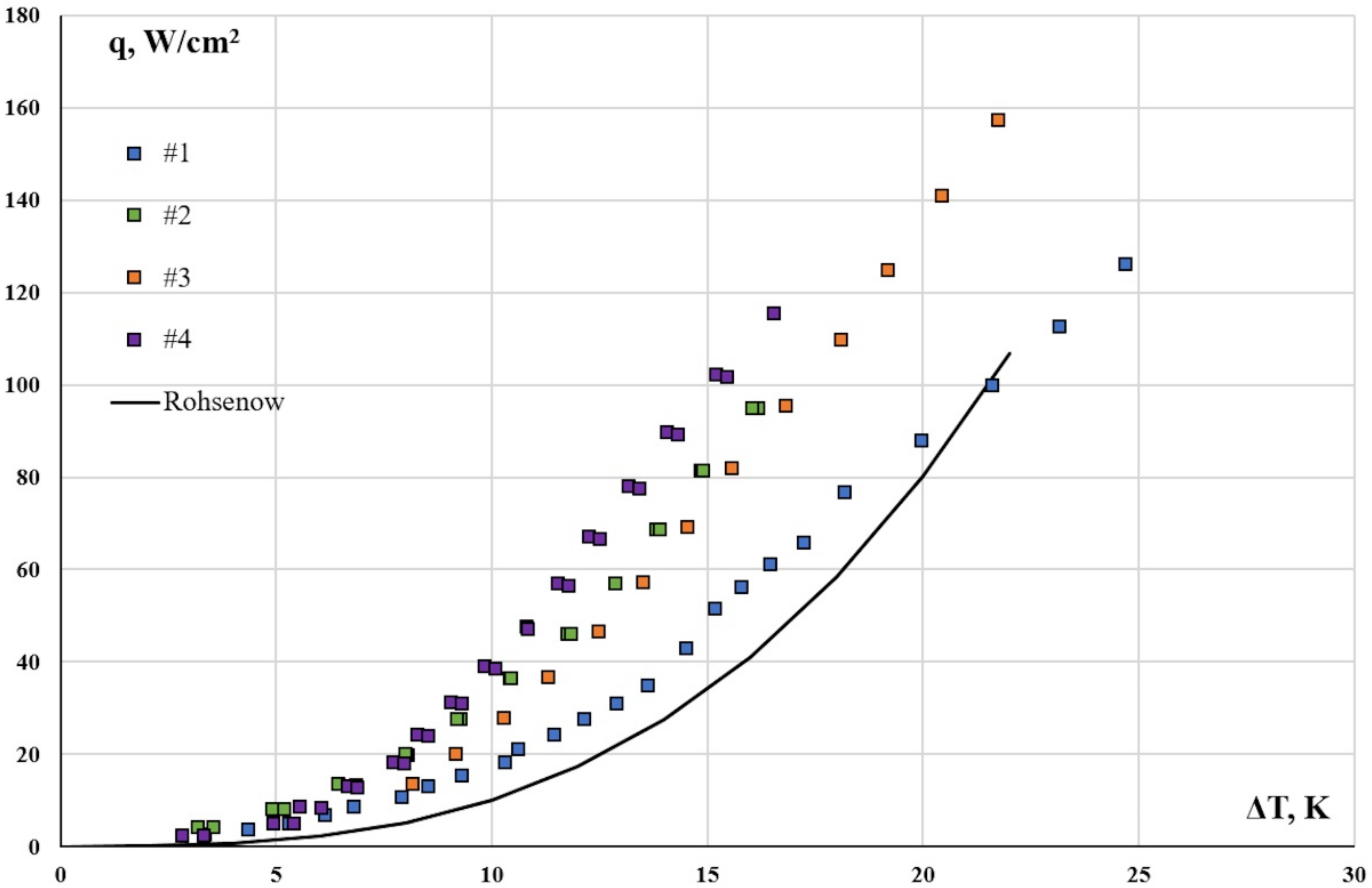
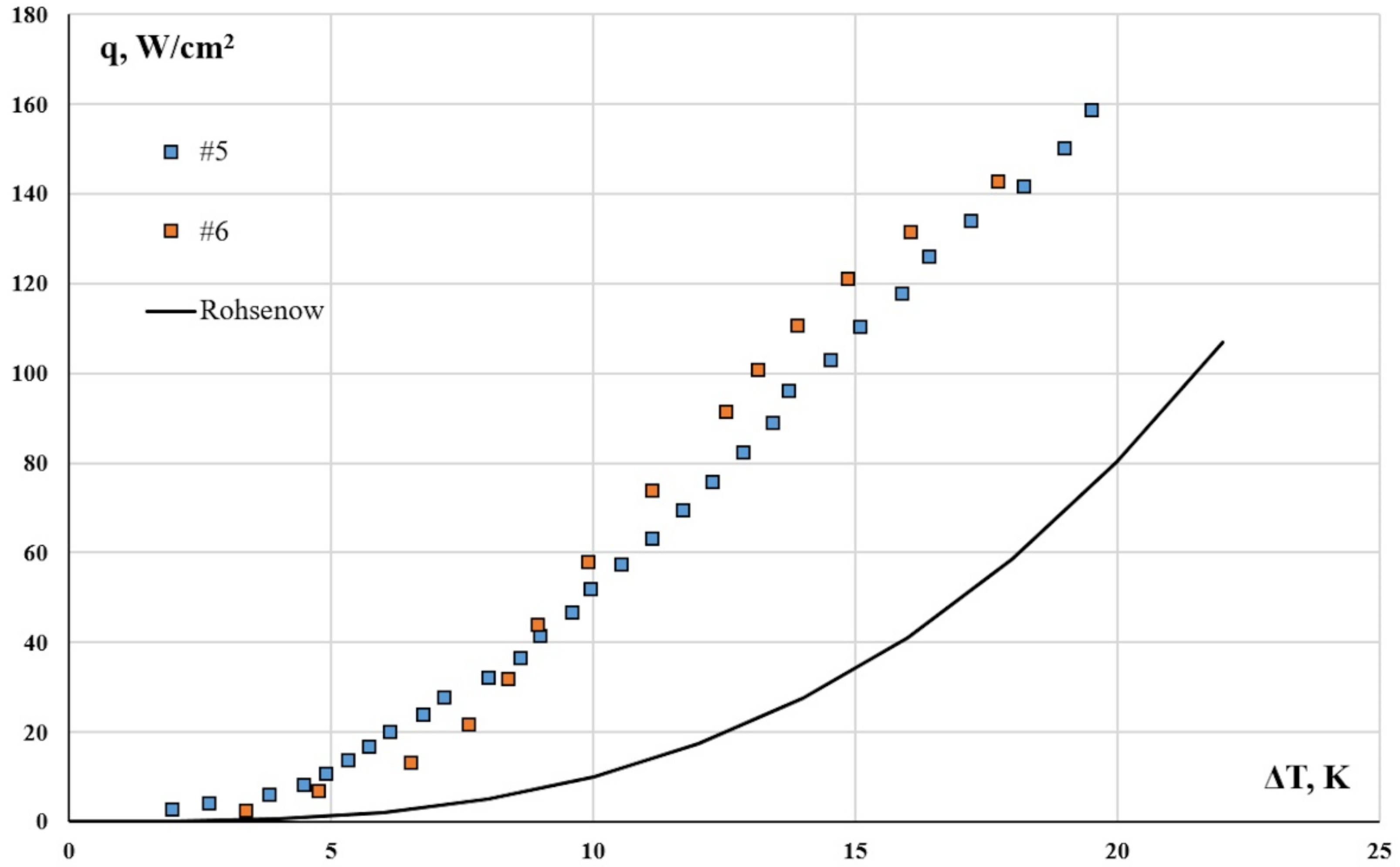
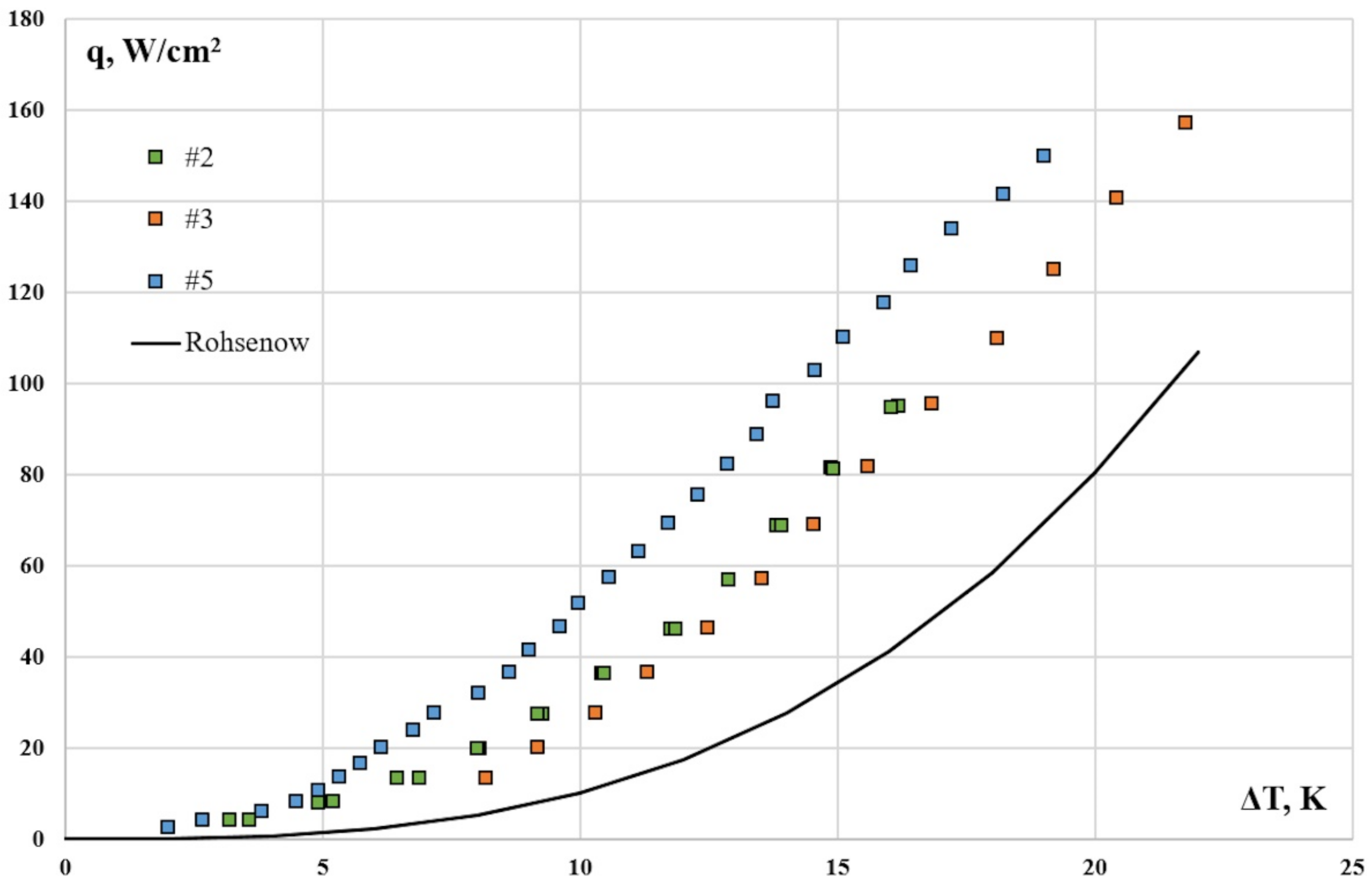
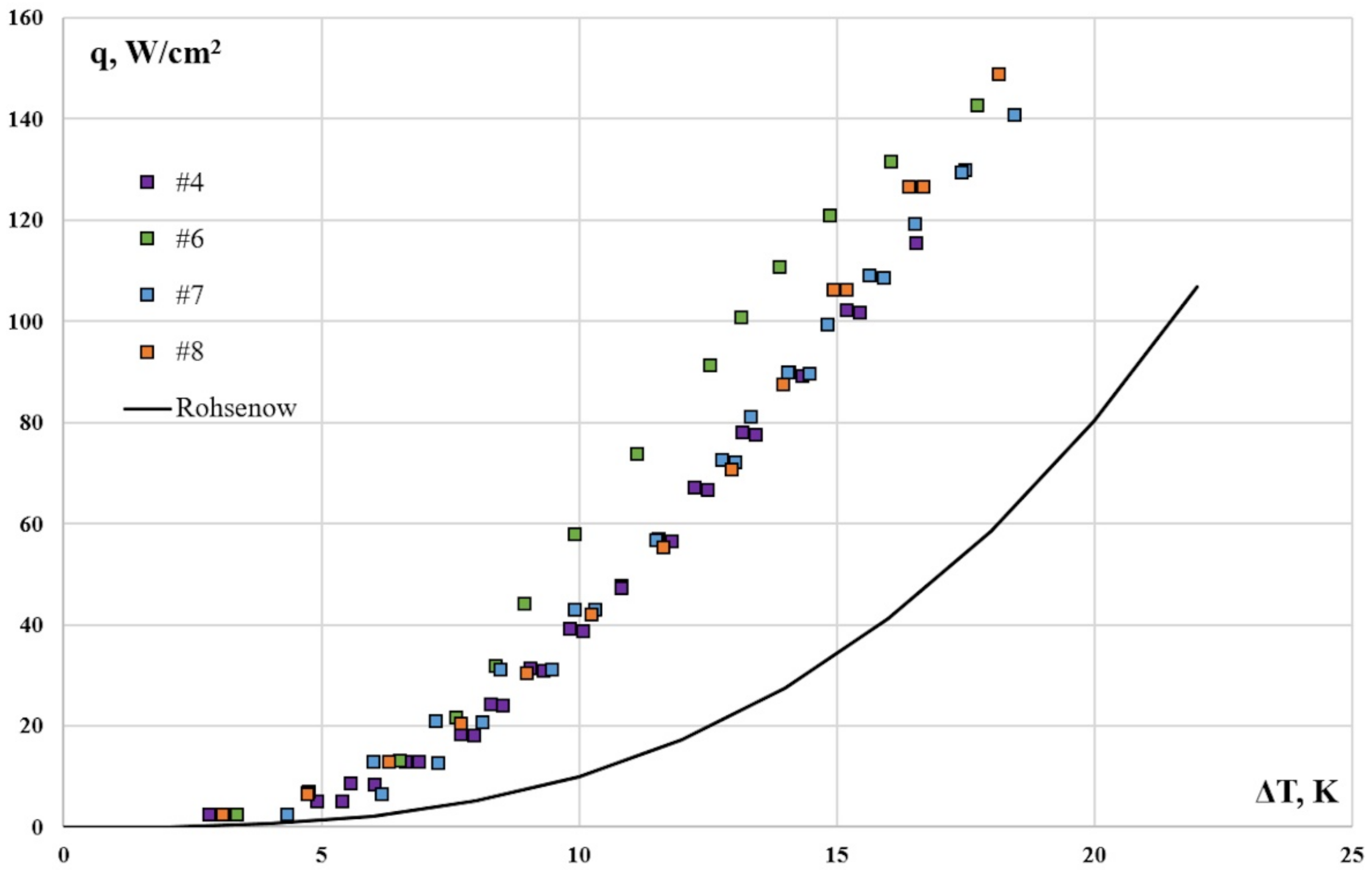
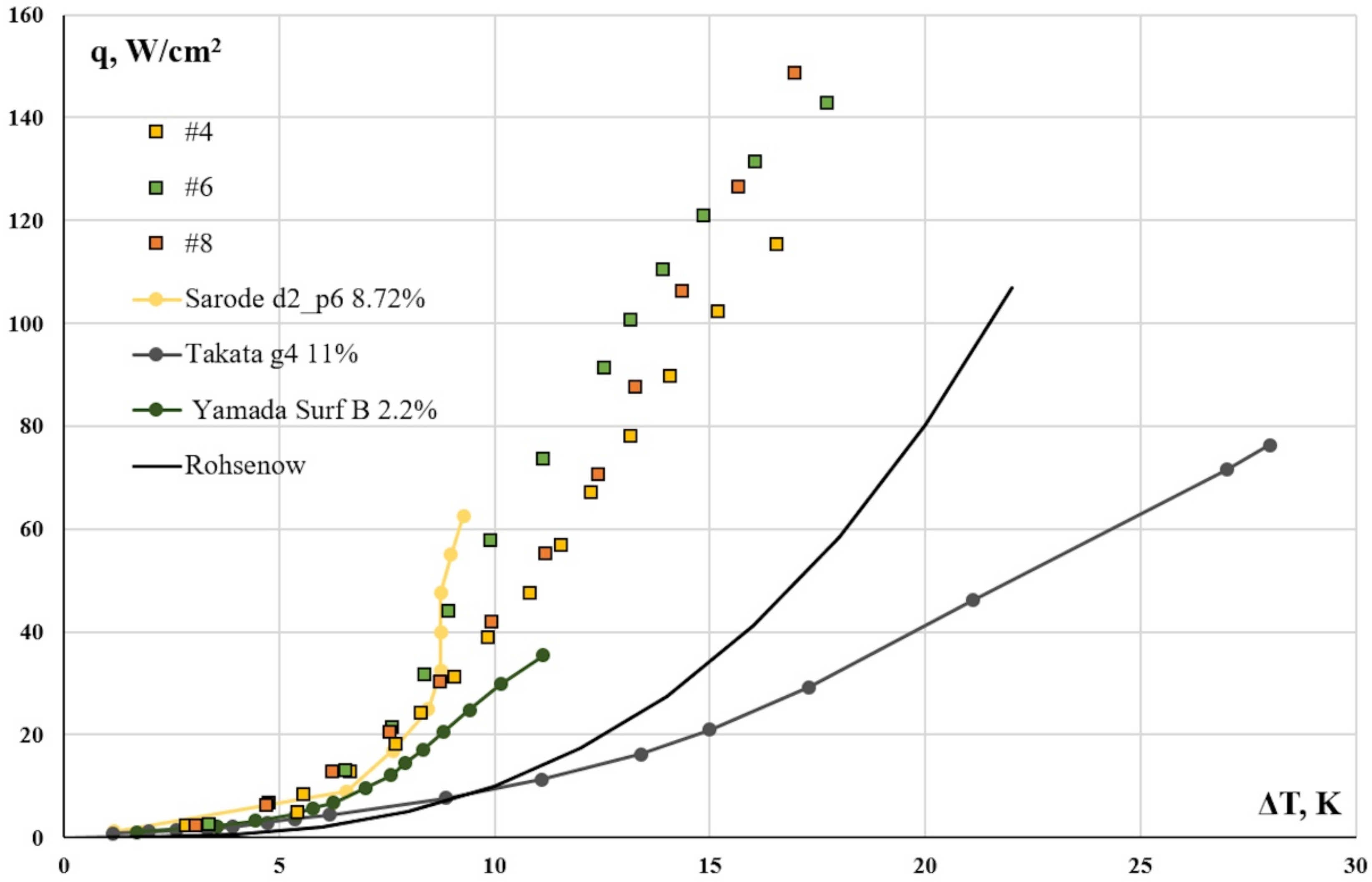

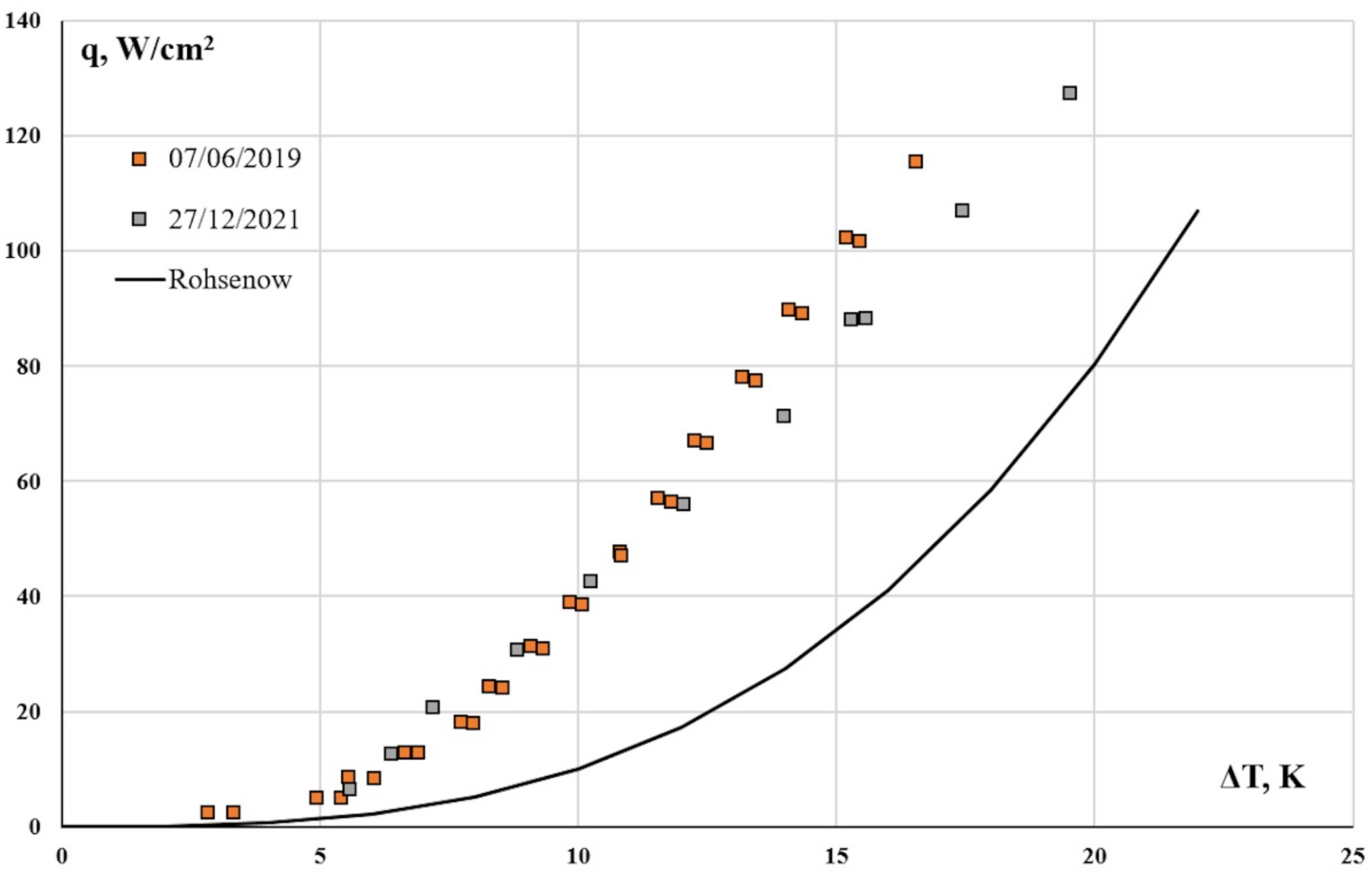

| Surface Number | Type of Surface Texture | Hydrophobic Coating | Shape and Size of Hydrophobic Spots | Spot Pitch and Number of Spots | Area Ratio |
|---|---|---|---|---|---|
| 1 | Micrococoons from SiOx nanowires | No | No | No | 0 |
| 2 | Micrococoons from SiOx nanowires | Fluoropolymer HWCVD | 0.1 mm diameter circle | 0.5 mm, 69 | 2.8% |
| 3 | Micrococoons from nanowires SiOx | Fluoropolymer HWCVD | 0.1 mm diameter circle | 0.5 mm, 69 | 2.8% |
| 4 | Smooth copper surface | Fluoropolymer HWCVD | 0.1 mm diameter circle | 0.5 mm, 69 | 2.8% |
| 5 | Micrococoons from SiOx nanowires | Fluoropolymer HWCVD | 0.05 mm diameter circle | 0.2 mm, 506 | 5.1% |
| 6 | Smooth copper surface | Fluoropolymer HWCVD | 0.05 mm diameter circle | 0.2 mm, 506 | 5.1% |
| 7 | Copper surface with an array of cavities formed by laser ablation | Hydrophobization by chemisorption of fluorinated methoxysilane | Triangular cross-section cavity with an effective diameter of 0.07 mm | 0.78 mm, 32 | 2.1% |
| 8 | Copper surface with an array of cavities formed by laser ablation | Hydrophobization by chemisorption of fluorinated methoxysilane | Rectangular cross-section cavity with an effective size of 0.1 mm | 0.78 mm, 32 | 3.4% |
Publisher’s Note: MDPI stays neutral with regard to jurisdictional claims in published maps and institutional affiliations. |
© 2022 by the authors. Licensee MDPI, Basel, Switzerland. This article is an open access article distributed under the terms and conditions of the Creative Commons Attribution (CC BY) license (https://creativecommons.org/licenses/by/4.0/).
Share and Cite
Chinnov, E.A.; Khmel, S.Y.; Vladimirov, V.Y.; Safonov, A.I.; Semionov, V.V.; Emelyanenko, K.A.; Emelyanenko, A.M.; Boinovich, L.B. Boiling Heat Transfer Enhancement on Biphilic Surfaces. Energies 2022, 15, 7296. https://doi.org/10.3390/en15197296
Chinnov EA, Khmel SY, Vladimirov VY, Safonov AI, Semionov VV, Emelyanenko KA, Emelyanenko AM, Boinovich LB. Boiling Heat Transfer Enhancement on Biphilic Surfaces. Energies. 2022; 15(19):7296. https://doi.org/10.3390/en15197296
Chicago/Turabian StyleChinnov, Evgeny A., Sergey Ya. Khmel, Victor Yu. Vladimirov, Aleksey I. Safonov, Vitaliy V. Semionov, Kirill A. Emelyanenko, Alexandre M. Emelyanenko, and Ludmila B. Boinovich. 2022. "Boiling Heat Transfer Enhancement on Biphilic Surfaces" Energies 15, no. 19: 7296. https://doi.org/10.3390/en15197296
APA StyleChinnov, E. A., Khmel, S. Y., Vladimirov, V. Y., Safonov, A. I., Semionov, V. V., Emelyanenko, K. A., Emelyanenko, A. M., & Boinovich, L. B. (2022). Boiling Heat Transfer Enhancement on Biphilic Surfaces. Energies, 15(19), 7296. https://doi.org/10.3390/en15197296









